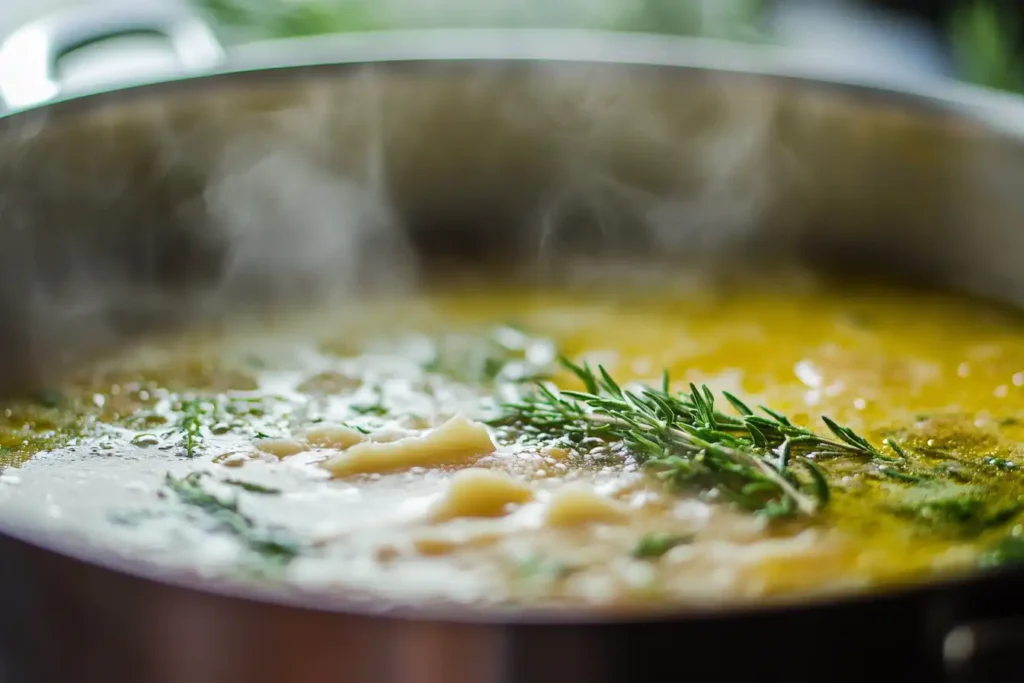Soup is one of the most comforting dishes you can make, and Parmesan cheese has long been a secret weapon for enhancing both flavor and texture. But does it actually thicken soup, or is it just a tasty addition? This article dives deep into how Parmesan cheese interacts with soups, its thickening properties, and the best ways to use it for maximum effect. From understanding its unique chemistry to solving common cooking issues, you’ll find everything you need to know about this culinary delight. Let’s get started!
What Makes Parmesan Cheese Unique for Cooking?
Introduction to Parmesan Cheese
Parmesan cheese, or Parmigiano-Reggiano, is hailed as the “king of cheeses” for a reason. Known for its sharp, nutty flavor and grainy texture, it’s a staple in Italian cuisine and beyond. But why is it such a favorite for soups? Parmesan’s versatility makes it a standout choice for both flavor and consistency enhancement, especially in broth-based or creamy soups.
Crafted from cow’s milk and aged for up to 36 months, Parmesan’s distinct properties allow it to melt beautifully, making it an ideal candidate for thickening soups while adding a rich umami punch. It’s also low in moisture compared to softer cheeses, which explains why it behaves differently when cooked.
The Chemistry of Parmesan Cheese
What makes Parmesan such a game-changer in the kitchen? It all boils down to its composition. Parmesan is rich in casein proteins and milk fat, which break down under heat. When grated or used as a rind, it releases these components into the liquid, creating a creamy texture.
Interestingly, the cheese’s granular structure ensures it doesn’t just melt away like butter it integrates into the soup, giving it body without overwhelming the base. Whether you’re working with a broth or a cream-based soup, Parmesan cheese works wonders to thicken while maintaining a smooth consistency.
How Parmesan Cheese Thickens Soup
The Thickening Process Explained
So, does Parmesan cheese thicken soup? The short answer is yes! Parmesan cheese is a natural thickening agent due to its protein and fat content. When added to a hot soup, the cheese melts and emulsifies, binding with the liquid. This process creates a velvety consistency that’s hard to achieve with other ingredients.
Adding Parmesan rinds to your soup works similarly but in a slower, more subtle way. As the rind simmers, it releases its essence, thickening and flavoring the broth simultaneously. Whether grated or in rind form, Parmesan adds both body and a savory depth to soups.
What’s even more magical is how Parmesan integrates into the soup without clumping provided you use the right technique. When stirred into a hot base, the cheese disperses evenly, giving the soup a rich, creamy texture.
Factors Influencing Thickening
How much Parmesan cheese you use matters a little can go a long way. Adding too much grated cheese can overwhelm the soup, while too little may not provide enough thickening. Start with a tablespoon or two, and gradually increase as needed.
Another crucial factor is the type of soup base. Broth-based soups benefit greatly from Parmesan’s emulsifying properties, while cream-based soups become even silkier. Temperature control is key, too. Adding cheese to boiling soup may cause curdling. Instead, stir it in gradually over low to medium heat for the best results.
Whether you’re using Parmesan for a bisque, chowder, or simple vegetable soup, its ability to thicken and enhance texture is unmatched. Now that we’ve explored how Parmesan works its magic, let’s look at the best ways to incorporate it into your soups.
Best Ways to Incorporate Parmesan Cheese in Soup

Using Grated Parmesan Cheese
Grated Parmesan is the easiest way to thicken soup and add flavor. Simply sprinkle it in during the final stages of cooking and stir thoroughly to ensure even distribution. Its fine texture allows it to dissolve quickly, making it ideal for soups like minestrone or tomato bisque. Plus, grated Parmesan acts as both a thickener and a garnish double duty, indeed!
When adding grated cheese, avoid dumping it all at once. Instead, add it in small batches, stirring continuously. This prevents clumping and ensures a smooth texture. Remember, Parmesan is naturally salty, so taste your soup before adding extra salt.
Cooking with Parmesan Rinds
Parmesan rinds are a hidden gem in the culinary world. Often discarded, these hard edges of the cheese wheel are packed with flavor and thickening potential. To use them, simply toss a rind into your soup as it simmers. Over time, it will release its rich, nutty essence into the liquid, thickening the base while infusing a subtle umami note.
Once your soup is ready, you can remove the rind or blend it in for a thicker consistency, depending on your preference. Soups like French onion, Italian wedding, or chicken noodle are perfect candidates for this method.
Whether you’re using grated cheese or a rind, Parmesan cheese is versatile, flavorful, and the perfect solution for thickening soups. Now that you know how to use it effectively, let’s address some common issues you might encounter.
Common Issues and Solutions When Using Parmesan Cheese
Avoiding Clumps and Curdling
One of the most frustrating moments when adding Parmesan to soup is finding clumps or curdled cheese. But don’t worry there are simple ways to avoid this. First, never add Parmesan to boiling soup; instead, lower the heat to a simmer. The intense heat can cause the proteins to separate, leading to an unpleasant texture.
Another tip is to grate the Parmesan finely before adding it to your soup. Finer cheese melts more evenly, reducing the risk of clumping. If you notice clumps forming, a quick whisk or immersion blender can help smooth things out. Wondering, does Parmesan cheese thicken soup without clumping? The answer lies in stirring continuously as you add it in small batches.
Lastly, consider the type of soup. Acidic bases, like tomato soup, may react with the cheese differently than cream-based soups. For these, balance the pH by adding a small amount of cream or baking soda to neutralize the acidity.
Balancing Flavors
Parmesan cheese is known for its bold, salty flavor, which can sometimes overpower delicate soups. To maintain a harmonious balance, use Parmesan sparingly and taste as you go. Pairing Parmesan with complementary ingredients like fresh herbs, garlic, or lemon zest can help balance its richness.
If your soup becomes too salty after adding Parmesan, a quick fix is to dilute it with more broth or add a starchy component like potatoes to absorb the excess salt. By following these tips, you can avoid common pitfalls and ensure your soup is both flavorful and smooth.
Alternatives to Parmesan Cheese for Thickening Soup
Cheese Substitutes
If you’re out of Parmesan or need a substitute, there are plenty of options to explore. Pecorino Romano is a close alternative, offering a similar sharp flavor with slightly more saltiness. Asiago cheese is another excellent choice for thickening and adding a creamy texture to soups. Both melt well and can achieve results close to Parmesan.
For those looking for a milder option, Gouda or Fontina cheeses work beautifully. They melt easily and create a smooth consistency without overpowering the dish. However, keep in mind that these cheeses won’t have the same umami depth as Parmesan.
Non-Dairy Alternatives
For dairy-free cooks, nutritional yeast is a fantastic substitute. It mimics Parmesan’s nutty flavor and acts as a natural thickener when combined with starchy vegetables like potatoes or cauliflower. Another option is plant-based Parmesan made from cashews or almonds, which can provide both flavor and texture without dairy.
For more delicious recipes and inspiration for your kitchen adventures, check out Favorite Flavor Recipes for a variety of creative ideas!
Whether you’re using traditional Parmesan or a substitute, the key is to experiment and find the flavor that suits your soup best. Now that we’ve explored these alternatives, you’ll always have a way to enhance your soups, even without Parmesan.
FAQs About Parmesan Cheese and Soup
Does Parmesan Cheese Add Flavor or Just Thickness?
Absolutely! Parmesan cheese does more than just thicken soup it adds a rich, nutty flavor that enhances the dish’s overall taste. Its umami quality, often referred to as a “savory explosion,” elevates the simplest broths into gourmet experiences. So, when you’re wondering, does Parmesan cheese thicken soup, the answer is yes but its flavor contribution is just as important.
Can Parmesan Cheese Be Used in All Soup Types?
While Parmesan works wonderfully in most soups, it shines brightest in cream-based or broth-based recipes. However, its strong flavor might overpower delicate soups, like light vegetable broths. Always consider the soup’s base before adding Parmesan. For clear soups, use rinds to add depth without clouding the liquid.
What is the Effect of Parmesan Cheese on Soup Consistency?
Parmesan cheese thickens soups by emulsifying into the liquid, creating a silky, creamy texture. Whether grated or in rind form, it provides both a subtle thickening and a luxurious mouthfeel.
FAQs from Google’s ‘People Also Ask’
Can Parmesan Cheese Thicken Without Curdling?
Yes, it can! To avoid curdling, add Parmesan cheese to warm not boiling soup. Stir it in gradually, letting it melt completely before adding more. This method prevents clumps and ensures a smooth texture.
Why is Parmesan Rind Recommended for Soups?
Parmesan rinds are loaded with flavor and natural thickeners. When simmered, they release oils and proteins that both enhance the soup’s taste and subtly thicken the broth.
Does Parmesan Add Umami to Soup?
Absolutely. Parmesan cheese is rich in glutamates, which provide that signature umami kick, making your soup taste fuller and more satisfying.
Conclusion and Final Tips for Cooking with Parmesan Cheese
Recap of Parmesan’s Unique Qualities
Parmesan cheese is truly a star ingredient, offering both flavor and functionality in the kitchen. So, does Parmesan cheese thicken soup? Without a doubt! Its natural proteins and fats work seamlessly to create a creamy texture while its nutty, savory flavor transforms any soup into a gourmet dish. Whether you’re using grated Parmesan or simmering a rind, this cheese delivers impressive results every time.
Final Tips for Maximizing Parmesan’s Benefits
To get the best out of Parmesan, always add it gradually and over low heat. Use finely grated cheese for even melting and incorporate rinds for a slow infusion of flavor and thickness. Remember, Parmesan is naturally salty, so adjust your seasonings accordingly. Lastly, don’t be afraid to experiment combine Parmesan with fresh herbs, spices, or other cheeses to create your signature soup.
By mastering these techniques, you’ll elevate your soups from simple to sensational. Happy cooking!

